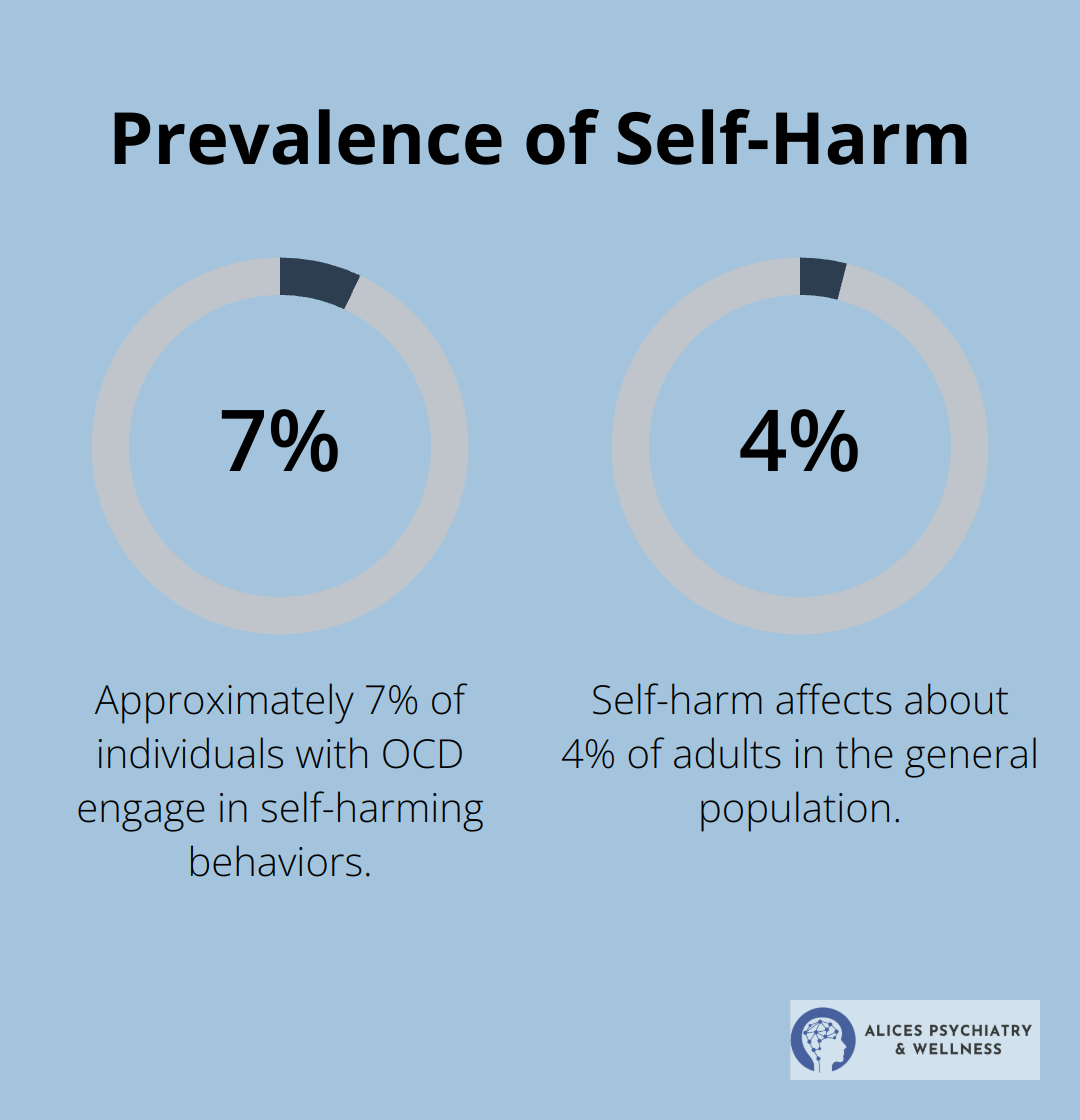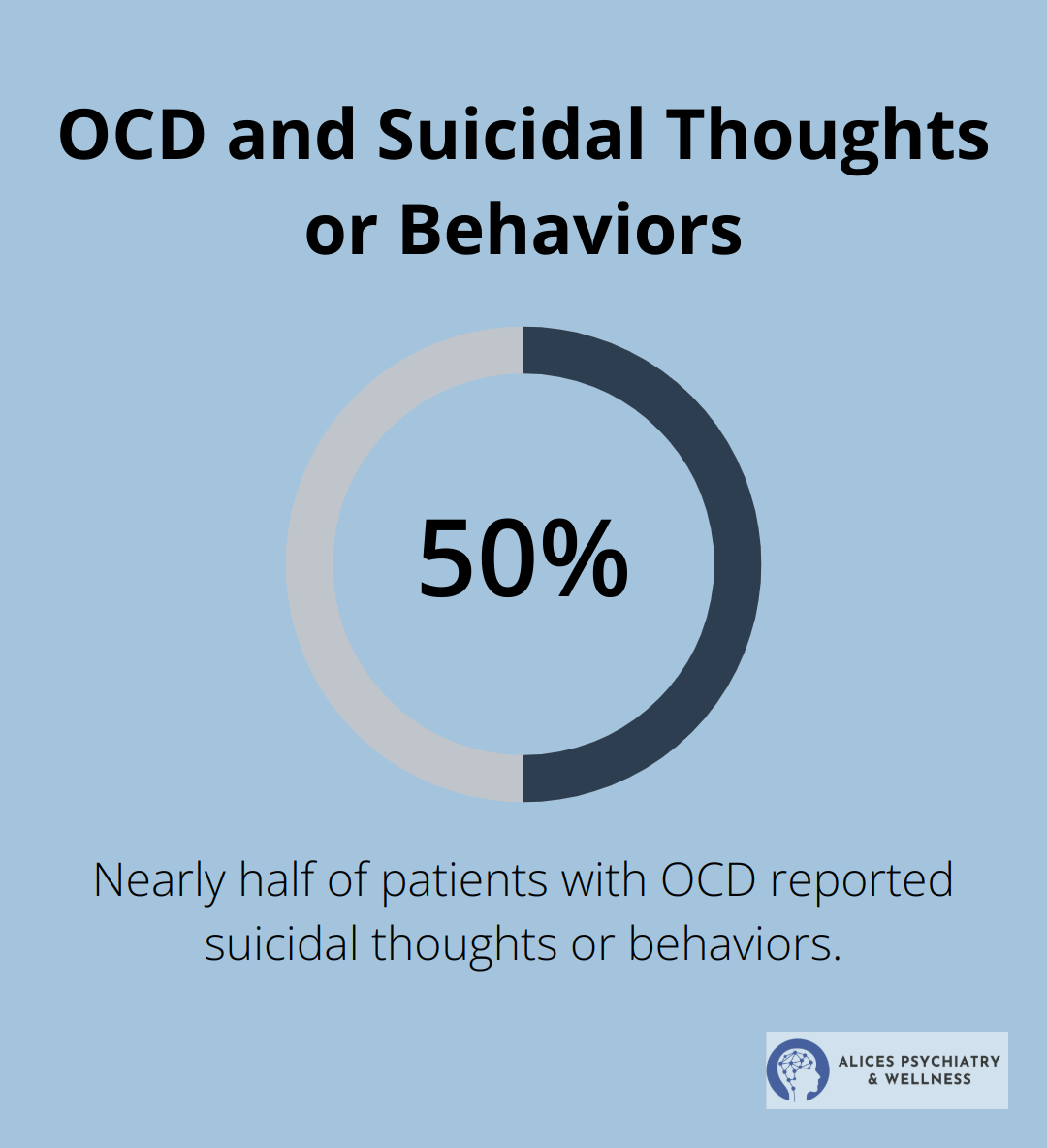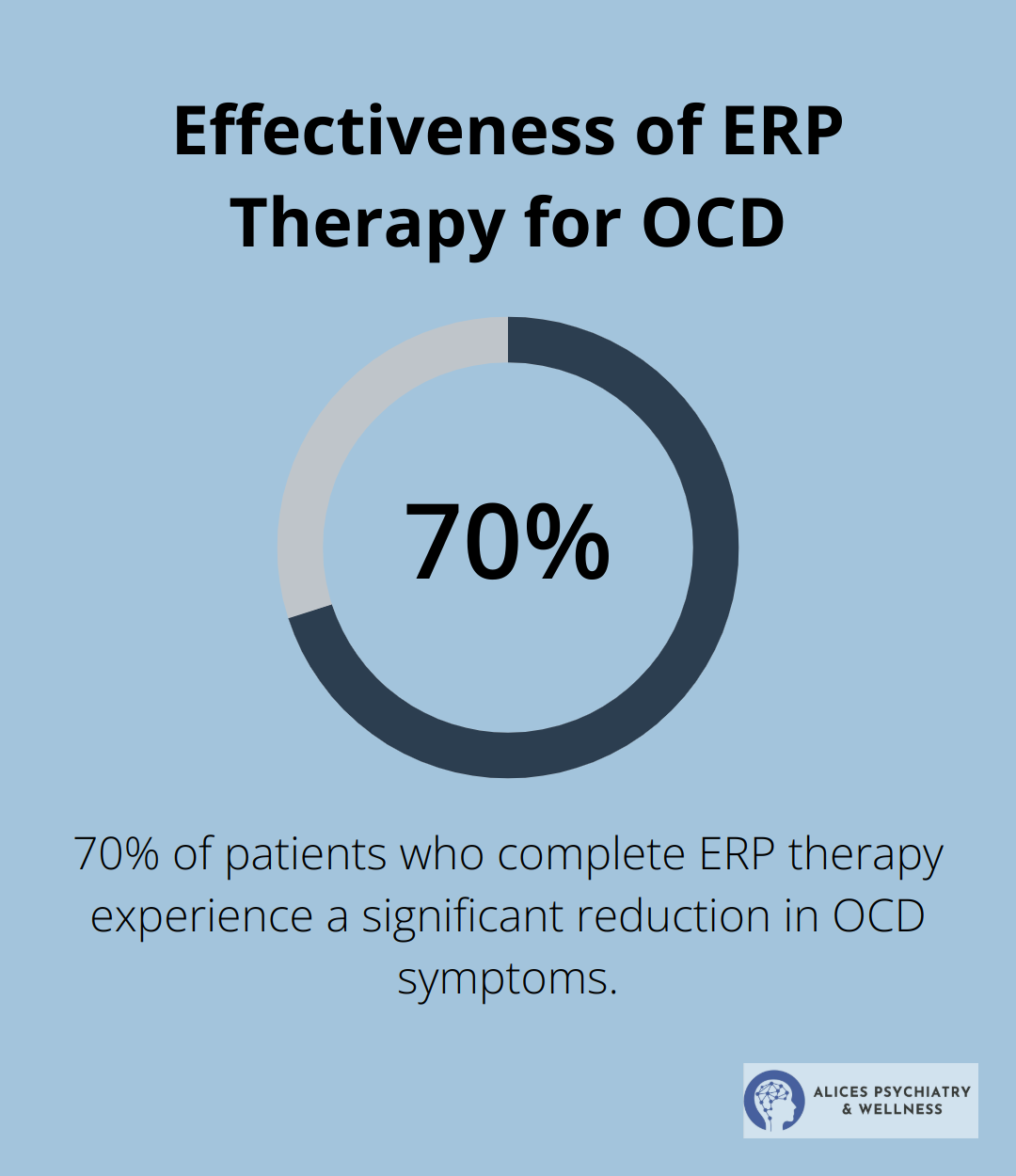At Alice’s Psychiatry and Wellness, we often encounter patients struggling with both OCD and self-harm behaviors. These two conditions can be deeply intertwined, creating a complex and challenging situation for those affected.
Understanding the connection between OCD and self-harm is vital for effective treatment and recovery. In this post, we’ll explore this relationship and discuss evidence-based approaches to help individuals break free from these harmful patterns.
The Link Between OCD and Self-Harm
Understanding OCD and Self-Harm
Obsessive-Compulsive Disorder (OCD) is a mental health condition characterized by persistent, intrusive thoughts (obsessions) and repetitive behaviors or mental acts (compulsions). These obsessions and compulsions can significantly interfere with daily life, causing distress and anxiety. Common obsessions include fears of contamination, harm, or making mistakes, while compulsions may involve excessive cleaning, checking, or counting.
Self-harm refers to the deliberate infliction of physical harm on oneself. This behavior can take various forms, such as cutting, burning, hitting, or scratching. It often serves as a way to cope with intense emotional pain or distress. While self-harm is not a mental illness itself, it frequently associates with various mental health conditions, including OCD.
The Prevalence of Self-Harm in OCD
Research shows a significant overlap between OCD and self-harm. A study published in the Journal of Clinical Psychology found that approximately 7% of individuals with OCD engage in self-harming behaviors. This rate is notably higher than in the general population, where self-harm affects about 4% of adults.

The connection between OCD and self-harm is complex. For some individuals with OCD, self-harm may serve as a compulsion, a way to temporarily relieve anxiety caused by obsessive thoughts. For others, it might function as a coping mechanism for the intense emotions and stress that often accompany OCD.
The OCD-Self-Harm Cycle
The relationship between OCD and self-harm often forms a cycle. Obsessive thoughts can trigger intense anxiety or distress, leading to self-harm as a form of relief or distraction. However, this relief typically lasts for a short time and may follow with feelings of guilt or shame, which can then fuel further obsessive thoughts.
It’s important to note that not all individuals with OCD engage in self-harm, and not all who self-harm have OCD. However, when these two issues co-occur, they can create a particularly challenging situation that requires specialized treatment.
Breaking the Cycle
Breaking the cycle of OCD and self-harm requires a comprehensive approach. Cognitive Behavioral Therapy (CBT), particularly a specialized form called Exposure and Response Prevention (ERP), has shown significant effectiveness in treating OCD. Research has shown that ERP can reduce depressive symptoms of OCD patients by 44.2% on average and reduce anxiety symptoms by 47.8% on average. For self-harm, Dialectical Behavior Therapy (DBT) can help in developing healthier coping mechanisms.
Medication, such as selective serotonin reuptake inhibitors (SSRIs), may also play a role in managing OCD symptoms. However, a qualified healthcare professional should always prescribe and monitor medication.
The Role of Professional Help
Professional help plays a vital role in addressing the complex relationship between OCD and self-harm. Mental health experts (like those at Alice’s Psychiatry and Wellness) can provide tailored treatment plans that address both conditions simultaneously. These plans often combine therapy, medication management, and skills training to help individuals develop healthier coping strategies and break the cycle of OCD and self-harm.
As we move forward, let’s explore specific treatment approaches that have proven effective in managing OCD-related self-harm behaviors.
The Intricate Web of OCD and Self-Harm
The Spiral of Obsessive Thoughts
OCD and self-harm often intertwine in complex ways, creating a challenging cycle for those affected. Obsessive thoughts in OCD can be relentless and distressing. For some individuals, these thoughts become so overwhelming that self-harm appears as a temporary escape. A study found that nearly half of the patients with OCD reported suicidal thoughts or behaviors, highlighting the significant link between these two issues.

These obsessive thoughts often revolve around themes of contamination, harm, or moral failings. For example, a person might have intrusive thoughts about harming loved ones, leading to intense guilt and anxiety. In an attempt to cope with these emotions, they might turn to self-harm as a form of self-punishment or distraction.
Self-Harm as a Compulsive Act
In some cases, self-harm becomes a compulsive behavior itself, intertwining with OCD rituals. This can manifest in various ways:
- Ritualistic self-harm: Some individuals might engage in self-harm as part of a specific ritual to neutralize obsessive thoughts.
- Symmetry-related self-harm: The need for symmetry or “evening up” sensations can lead to repetitive self-harm on both sides of the body.
- Checking behaviors: Self-harm might be used as a way to “check” physical sensations or to ensure one is still alive (particularly in cases of existential OCD).
The Role of Emotional Dysregulation
Emotional dysregulation is frequently linked to self-harm and plays a significant role in both OCD and self-harm. Many individuals with OCD struggle to manage intense emotions, particularly anxiety and distress. Self-harm often serves as a maladaptive coping mechanism for these overwhelming feelings.
Breaking the Cycle
To break the cycle of OCD and self-harm, mental health professionals focus on teaching healthier coping strategies to manage intense emotions. Techniques such as mindfulness, deep breathing exercises, and progressive muscle relaxation can be powerful tools in this process.
It’s important to note that while the connection between OCD and self-harm is strong for some individuals, not everyone with OCD will engage in self-harm, and not all self-harm is related to OCD. Each person’s experience is unique, which is why personalized treatment approaches are so important in addressing these complex issues.
As we move forward, we’ll explore specific treatment approaches that have proven effective in managing OCD-related self-harm behaviors, including cognitive-behavioral therapy and medication options.
Effective Treatments for OCD and Self-Harm
Cognitive Behavioral Therapy: Rewiring Thought Patterns
Exposure and Response Prevention (ERP) is currently considered the treatment of choice for OCD, and is more effective than cognitive therapy or pharmacotherapy. This approach focuses on confronting fears and obsessions gradually without engaging in compulsive behaviors.
A study published in the Journal of Behavior Therapy and Experimental Psychiatry reported that CBT reduced OCD symptoms by an average of 60% in patients who completed a 12-week program. This significant improvement underscores the power of CBT in managing OCD-related behaviors (including self-harm).
Exposure and Response Prevention: Facing Fears Head-On
Exposure and Response Prevention (ERP) is a specialized form of CBT that’s particularly effective for OCD. In ERP, patients confront their fears and obsessions gradually without engaging in compulsive behaviors. This approach can challenge patients, but it’s incredibly effective. The International OCD Foundation reports that 70% of patients who complete ERP therapy experience a significant reduction in OCD symptoms.

For individuals with OCD-related self-harm, ERP might involve exposure to situations that trigger the urge to self-harm, while learning to resist this urge. This process helps break the cycle of obsessive thoughts leading to self-harm behaviors.
Medication: A Powerful Ally in Treatment
While therapy forms the foundation of treatment, medication can play a significant role in managing OCD and reducing self-harm urges. Selective Serotonin Reuptake Inhibitors (SSRIs) are the most commonly prescribed medications for OCD. These drugs work by increasing serotonin levels in the brain, which can help reduce obsessive thoughts and compulsive behaviors.
A meta-analysis examining different doses of SSRIs demonstrated that high-dose SSRI use led to better outcomes compared to medium and low doses. Finding the right medication and dosage often requires patience and close collaboration with a psychiatrist.
Dialectical Behavior Therapy: Building Emotional Resilience
Dialectical Behavior Therapy (DBT) is another effective approach, particularly for addressing self-harm behaviors. DBT focuses on the development of mindfulness, emotional regulation, and distress tolerance skills. These skills are important for individuals who use self-harm as a way to cope with intense emotions.
Research published in the journal Behaviour Research and Therapy showed that DBT reduced self-harm behaviors by up to 80% in individuals with borderline personality disorder (a condition often associated with self-harm). While this study didn’t specifically focus on OCD patients, the skills taught in DBT can prove invaluable for anyone struggling with self-harm urges.
Integrated Treatment Approach
An integrated approach, combining therapy, medication management, and skills training, offers the best chance for long-term recovery from OCD and self-harm behaviors. This comprehensive treatment plan should be tailored to each patient’s unique needs. Professional help from qualified mental health experts (such as those at Alice’s Psychiatry and Wellness) is essential for individuals struggling with OCD and self-harm.
Final Thoughts
OCD and self-harm create a complex and challenging situation, but recovery remains possible with proper support and treatment. Professional help plays a vital role in breaking the cycle of obsessive thoughts and harmful behaviors. Mental health experts provide personalized treatment plans that address both OCD and self-harm simultaneously, offering a path to lasting recovery.
A comprehensive approach to treatment combines therapy, medication management, and skills training for the best chance of long-term success. Cognitive Behavioral Therapy, particularly Exposure and Response Prevention, shows remarkable effectiveness in treating OCD. Dialectical Behavior Therapy helps develop healthier coping mechanisms for self-harm behaviors. Medication (when appropriate) can also significantly manage symptoms and support recovery.
At Alice’s Psychiatry and Wellness, we understand the unique challenges of OCD and self-harm. Our team of experienced mental health professionals provides compassionate, personalized care to help you on your journey to mental wellness. We offer virtual appointments across several states, ensuring accessible, high-quality care from your home. Take the first step towards recovery by scheduling a consultation today.





